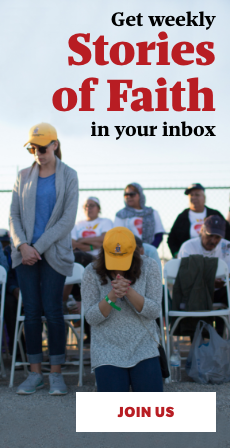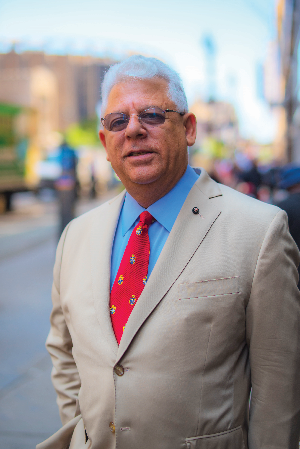
“I’m bullish,” said Mario Paredes, borrowing a phrase from a former employer, Merrill Lynch, in expressing the prospects for Hispanics to expand their leadership role in the U.S. Catholic Church.
He believes this is the perfect moment for Hispanics to step up to bigger responsibilities in the Church and for the Church to extend new possibilities to them. “We need to fully integrate into one Catholic Church,” he said.
Not only do Hispanics represent the largest, youngest and fastest-growing ethnic group in the U.S. Catholic Church, they are enriching the Church with their culture, traditions and vibrancy.
“Hispanics are a blessing to the U.S. Church,” said Paredes. “They are an injection of new life, vitality and energy.”
“But they need leadership skills and opportunities to bridge to the dominant culture,” he added. They need a bigger place at the table. “Through leadership training and education, particularly for the youth, Catholic Extension Society is making their voices strong.”
Dedicated to Hispanics
In addition to his corporate career overseeing Hispanic markets in business development at Merrill Lynch, the Chilean-born, Jesuit-educated Catholic founded the Northeast Hispanic Catholic Center, where he was executive director for 30 years. He has worked for the USCCB and the American Bible Society and co-founded the Catholic Association for Latino Leaders. He helped organize the first three Encuentros (encounters) in 1972, 1977 and 1985 —a national gathering with a focus to fully engage Hispanics in the U.S. Catholic Church. The fifth Encuentro, held in September in Dallas, was attended by more than 2,500 parishes. Paredes has published books, including The History of the National Encuentros: Hispanic Americans in One Catholic Church and Hispanics in the U.S.A.
He has spent years reflecting on the evolution of the Catholic Church in this country, particularly as it relates to immigrants.
Paredes explained that the first Catholics in this country were Hispanics missionaries who established small churches, mainly in the South and West. Then in the 19th and 20th centuries, European Catholics came, mainly to the Northeast and Midwest, and built an extensive Church infrastructure.
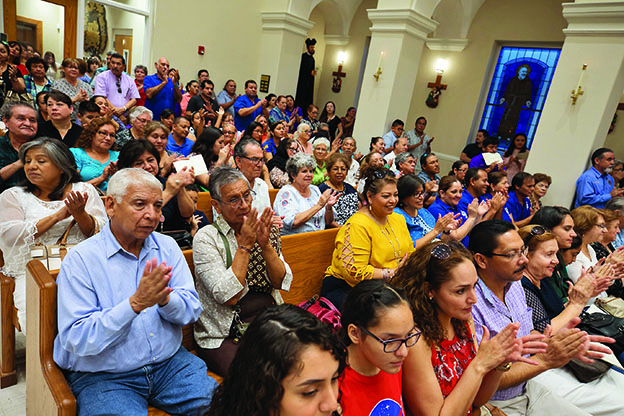
Latinos fill pews of many churches, particularly in Southwest
“Our Catholic institutions — parishes, rectories, schools, universities and hospitals — were built from the sweat and generosity of these past immigrants,” he said. “Our generation has never known the immigrant experience of building the Catholic Church in America. We just walked into these established places. We’ve had it easy; we don’t understand how complex it is to build the Church here.”
He made a further point: “When the European Catholic immigrants came, they brought their leaders with them: priests and religious sisters. These leaders accompanied and protected their congregations as they became established.”
Today’s generation of Hispanic immigrants arrive in the U.S. without leaders and meet a population that is not experienced in building up the Church. Neither side is prepared for this integration. Paredes recognizes this as a challenge but believes Hispanics are bringing so much vitality to the Church that the future is bright. “Because of their gifts, talents and presence, we are in the springtime of the Catholic Church in this country,” he said.
Fueling the Church
The Church in America is growing, largely due to immigrants. Fifty years ago, the United States had about 50 million Catholics. Now there are more than 70 million, with Hispanics responsible for more than 70 percent of this increase.
They represent 40 percent of the Catholic population, the largest ethnic group. Of U.S. Catholics under 18 years, 60 percent are Hispanic.
Paredes believes Hispanics make unique contributions to the Church. They have beautiful traditions, celebrations and devotions to the saints. Their values, particularly family values, enliven the Church. The concept of being missionary, and reaching out to help others, is natural for them. They feel a kinship with Pope Francis and his focus on the Scriptures and humility.
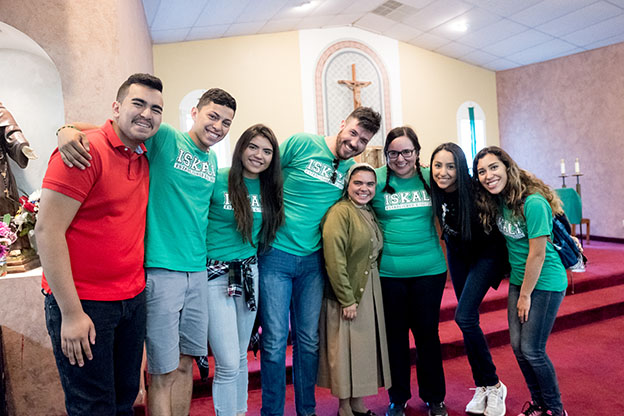
Hispanic youth from Chicago visit Sr. Maryud Cortés, who is part of Catholic Extension Society’s Latin American Sisters program, in Bangor, Michigan.
But many Hispanics who recently moved to the United States are still trying to mesh their own Catholic practices with the U.S. Church. They have not always felt welcome, and leadership roles for them have been lacking.
“It is getting better,” said Paredes. “Before, Masses in Spanish were only at odd times, such as 3 p.m. on Sunday in the church basement. It was not an inviting environment. Hispanics felt marginalized. But that is changing.”
Leadership opportunities are also emerging. “At the time of the first Encuentro, we had three Hispanic bishops nationally. Now there are 40. We also have more Hispanic lay leaders.”
Immigrants are changing the landscape of the U.S. Church and giving it a big boost.
Investing in leadership
Paredes said that Catholic Extension Society has played a big part in these changes. “Catholic Extension Society looks for people in the margins of the Church — those in the most difficult places. It invests in ministries and leadership training for Hispanics, through the U.S.-Latin American Sisters Exchange Program, the Hispanic Lay Leadership Initiative and the Young Adult Leadership Initiative,” he said. “It recognizes the unique pastoral needs of Hispanics, and invests in the infrastructure — building churches. Hispanics need a place to feel at home.”
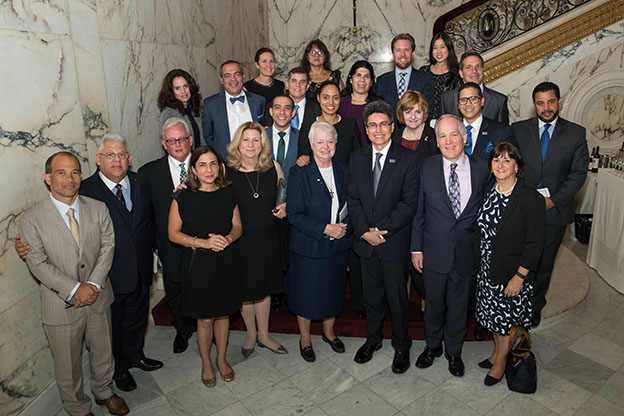
Mario Paredes, second from left, and colleagues attend Catholic Extension Society’s Spirit of Francis Award dinner in New York City.
He first heard of Catholic Extension Society years ago while working for Catholic bishops in conjunction with the Northeast Hispanic Catholic Center. His center received a Catholic Extension Society grant to develop catechists for Latino communities. Later, when he worked for the American Bible Society, they distributed Bibles to rural communities through a Catholic Extension Society partnership. “Catholic Extension Society understands the importance of building up the laity as well as encouraging Hispanic vocations,” he added. “They do this by training deacons, bilingual priests and catechists. They don’t just hand out financial resources; they are developing and expanding Church leadership.”
He knows that Hispanics need to take responsibility in establishing their role in the Church, but Catholic Extension Society is an “expression of solidarity to help with this integration,” he said.
“We are one Church,” he said. And with immigrants, it is bigger, stronger and more vibrant.
